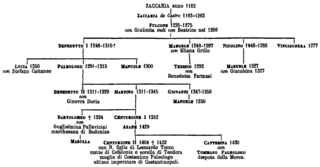During the late Middle Ages, the two cities of Argos and Nauplia formed a lordship within the Frankish-ruled Morea in southern Greece.
The margraviate or marquisate of Bodonitsa, today Mendenitsa, Phthiotis, was a Frankish state in Greece following the conquests of the Fourth Crusade. It was originally granted as a margravial holding of Guy Pallavicini by Boniface, first king of Thessalonica, in 1204. Its original purpose was to guard the pass of Thermopylae.
Francis Zorzi (1337–1388), called Marchesotto, was a member of the Venetian Zorzi family and the Marquess of Bodonitsa in Central Greece from 1345 to his death.
Nicholas ΙΙΙ Zorzi or Giorgi was the Marquess of Bodonitsa, a member of the Zorzi family of the Republic of Venice, from 1416 to 1436, though the title was purely nominal by then. Before becoming marquess in an exchange with his nephew Nicholas II, he was the baron of Carystus. He was a son of Guglielma Pallavicini and Marquess Nicholas I Zorzi.
Nicholas I Zorzi was a Marquess of Bodonitsa, and the first member of the Zorzi family of Venice to hold the post, from 1335 to his death. In 1335, he married Guglielma Pallavicini, heiress of Bodonitsa and widow of Bartolommeo Zaccaria.

The House of Pallavicini, also known as Pallavicino and formerly known as Pelavicino, is an ancient Italian noble family founded by Oberto II Pelavicino of the Frankish Obertenghi family.
Albert Pallavicini was the fifth marquess of Bodonitsa from his father's death until his own in 1311. His father was Thomas, a great-nephew of the first marquess, Guy. Albert married Maria dalle Carceri, a Venetian noblewoman from Euboea. He even obtained a sixth of that island.
Andrea Cornaro of the House of Cornaro, was a Venetian citizen from Crete, and baron of Scarpanto. He was the husband of Maria dalle Carceri, heiress of a sixth of Euboea and widow of Albert Pallavicini, and co-governed her half of the marquisate of Bodonitsa until his death.
Guglielma Pallavicini, the Lady of Thermopylae, was the last Pallavicino heir to rule in Bodonitsa. She ruled as Margrave of Bodonitza in 1311 – 1358. She was an infant when she succeeded her father Albert in 1311. She shared the margraviate with her mother Maria dalle Carceri and later with her stepfather Andrea Cornaro and her own husband Bartolomeo Zaccaria.

BartolomeoZaccaria was the first husband of Guglielma Pallavicini and thus Marquess of Bodonitsa in her right. He also carried the title Lord of Damala during his lifetime.

Louis Fadrique a Catalan nobleman who was Count of Salona, as well as lord of various other towns in Central Greece from ca. 1365 until his death in 1382. In 1375–1381 he also served as the vicar-general of the twin duchy of Athens and Neopatras.
Jacob Zorzi was the Marquess of Bodonitsa from 1388 to 1410. He was the last true ruler of Bodonitsa.
Florence Sanudo or Fiorenza, was Duchess of the Archipelago in 1362–1371, in co-regency with her second spouse.

The Triarchy of Negroponte was a crusader state established on the island of Euboea after the partition of the Byzantine Empire following the Fourth Crusade. Partitioned into three baronies run by a few interrelated Lombard families, the island soon fell under the influence of the Republic of Venice. From circa 1390, the island became a regular Venetian colony as the Realm of Negroponte.

Mendenitsa, in the Middle Ages known as Mountonitsa (Μουντονίτσα) and Bodonitsa or Vodonitsa (Βοδονίτσα), is a village in Phthiotis, Greece. Along with the nearby village of Karavidia, it forms a community in the municipal unit of Molos.
George I Ghisi was a Latin feudal lord in medieval Greece.

The Barony of Arcadia was a medieval Frankish fiefdom of the Principality of Achaea, located on the western coast of the Peloponnese peninsula in Greece, and centred on the town of Arcadia, ancient and modern Kyparissia.
Bartholomew II Ghisi was a Latin feudal lord in medieval Greece, lord of Tinos and Mykonos, Triarch of Negroponte and Grand Constable of the Principality of Achaea.
Carintana dalle Carceri was the co-ruler of Oreus and the northern third or terziere of the Lordship of Negroponte in Frankish Greece in circa 1240-1255. She was the second wife of William of Villehardouin, Prince of Achaea. Her childless death gave rise to the War of the Euboeote Succession involving Venice and most rulers of Frankish Greece.
Narzotto dalle Carceri was the ruler of the southern terziere, or third, of the Lordship of Negroponte in Frankish Greece from 1247 to 1264. He married Felisa, a daughter of William I of Verona.





